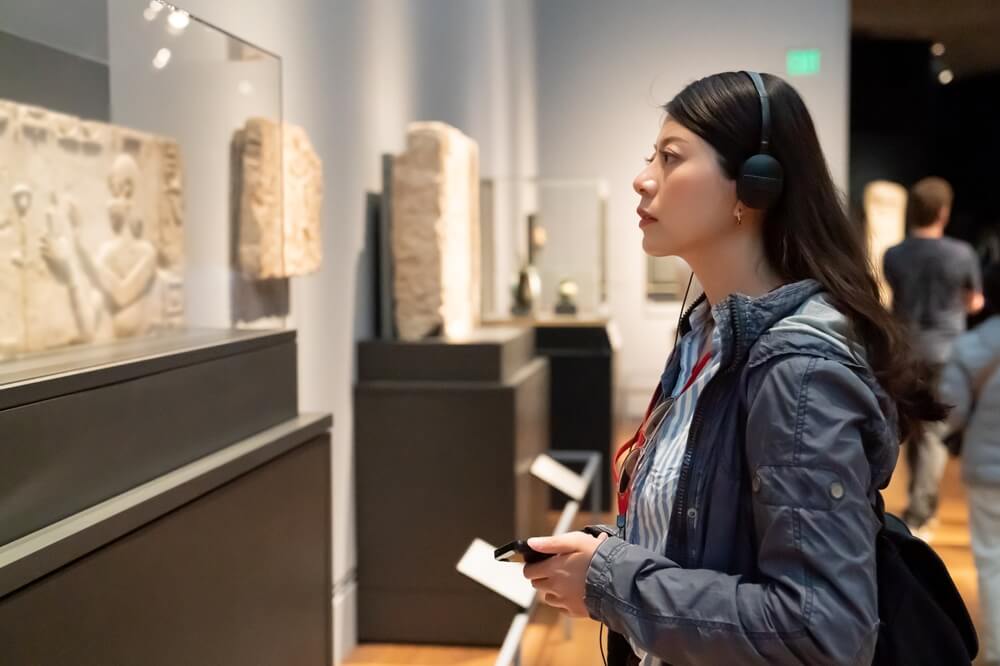Earning a degree in art education can be a rewarding path for those with a passion and eye for art who want to share their knowledge with young people. Aside from traditional art teacher roles, various careers with an art education degree allow graduates to immerse themselves in the art world while also finding professional and financial stability.
Introduction to Art Education Degrees
Art education degrees, such as a master’s in art education, offer students a chance to learn the skills necessary to share their love of art with students in a classroom or other educational setting. Potential students who are passionate about art education can earn either a Bachelor of Fine Arts (BFA), Master of Fine Arts (MFA), Master of Arts in Teaching (MAT), or even a Ph.D. in art education. The right degree program for any applicant will depend on their individual background, completion of prerequisite courses, and ultimate career goals.
Overview of an Art Education Degree
An art education degree program should provide a spectrum of coursework that includes both the study or art itself and instruction in pedagogy and teaching methodologies. Art education programs may include courses in the following disciplines:
- Art history
- Art criticism
- Multiculturalism
- Art studio practice
- Student teaching opportunities
- Experiential learning in classrooms, museums, galleries, etc.
The Broad Skills Acquired Through Art Education
An art education degree can impart students with a range of skills that can be applicable both in and out of the classroom, including:
- Critical thinking
- Color theory
- Analytical skills
- Observational skills
- Reading comprehension and writing
Traditional Career Paths in Art Education
Using an art education degree to become an art teacher is perhaps the most common career trajectory. Graduates of art education degree programs often go on to teach in K-12 schools, community arts programs, or other art class formats.
Teaching in K-12 Schools
Teaching with an art education degree is a natural path to follow. In New York State, K-12 teachers can begin their teaching careers with an undergraduate degree, but they must earn a master’s degree within five years of beginning their careers. An MAT degree can help working art teachers fulfill this licensing requirement, or it can be an option for those who want to make a career change and start teaching art.
A K-12 art teacher can work in public or private schools, working with kids from kindergarten through high school. Art teachers typically help students learn about various artistic media through hands-on education. This often includes ceramics, watercolors, collage, and photography. Art teachers may also teach specialty classes that focus on art history, criticism and analysis, or one specific medium for an entire semester or year.
Art teachers in the K-12 environment may be responsible for other duties intended to help support the school. This could include monitoring lunchrooms and hallways, tutoring, or advising specialty afterschool groups or clubs.
Community Arts Programs
Working for a community arts program may be another career option for graduates of art education programs. Many communities have arts programs available to the public that are built around a certain underserved population, an institution of higher learning, or a private philanthropic program.
Students in community arts programs may vary significantly in age, giving teachers a chance to work with populations older or younger than the K-12 demographic. In some cases, community arts programs may be funded by private institutions, such as a museum, or by government programs.
Expanding Beyond Traditional Roles
Many job opportunities exist for art education graduates beyond a typical educator career path. Graduates of art education degree programs may go on to work in museums, art therapy practices, and even in the corporate world.

Museum Education and Curation
Although many people visit museums as passive observers, the truth is that museums are places of learning, discovery, and education. Art museums specifically offer opportunities for art education graduates to gain a professional foothold that allows them to contribute to these experiences. Museum art educators may work in museum-based classrooms, creating curriculum related to the museum’s collection or traveling exhibits, or they may work with curators to develop guided tours and new exhibits in line with the institution’s educational goals.

Art Therapy
Art therapy is a process that helps address mental health issues through creating art and engaging in therapeutic creative practice. While a degree in art education is a first step toward working in art therapy, to become a certified practitioner, art therapists must earn a master’s degree with a specific art therapy focus. Prospective art therapists must complete at least 100 hours of supervised practicum and 600 hours of supervised art therapy clinical internship, which are not part of a standard art education degree.
However, while working to complete these requirements, individuals with art education degrees may work in tandem with therapists to assist them as they continue their education.
Corporate Art Consultants
Graduates of art education programs who want to expand their career horizons beyond education may consider a corporate art consultant career. Corporate art consultants work with companies to select art pieces for their corporate environments, whether that means decorating hotel lobbies or executive offices. A degree in art education, with its foundational knowledge of art as well as its focus on teaching others about the significance of art, is a great launching pad for this type of career.
Art Education in the Digital Realm
More and more art education and professional work in the art world is digital. Million-dollar advertising campaigns can be created entirely on an iPad or laptop, meaning that digital art is not the future of art but very much the present. Art educators should be well-versed in digital art and may choose to make their careers in the digital space.
Digital Media and Graphic Design
Digital media and graphic design jobs are in high demand. For instance, according to the Bureau of Labor Statistics (BLS), nearly 9,000 new graphic design jobs are expected to be created between 2022 and 2032. Graphic designers can work in virtually any setting, from freelance self-employment projects to corporate projects for Fortune 500 companies. After completing an art education degree, some graduates may decide they would rather continue making their own creations, and graphic design may be the way they choose to do so profitably.
Animation and Game Design
Animation and game design is another potentially fulfilling and lucrative option for those with artistic experience. Animators and game designers work alongside copywriters, editors, and creative directors to create animations and visual effects for anything from console video games and mobile games to television and advertising.
According to the BLS,4 the demand for animators and special effects artist positions is expected to grow by 8% between 2022 and 2032, which is faster than the average for all jobs. In addition, the 2023 median pay for animators was $99,060 per year.
Animators and game design artists can also work in a variety of environments, including for video game companies, mobile game companies, advertising agencies, and other types of corporate clients. An educational background can be helpful in these types of positions where art works along with commerce and artistic choices to complete well-rounded projects.
Entrepreneurial Opportunities for Art Educators
Art educators with the entrepreneurial spirit have plenty of options available to them. After completing an art education degree, graduates may start their own art programs or work as freelance art instructors.
Starting Your Own Art School or Workshop
The day-to-day life of a teacher can be too constrictive for some art educators. Starting an independent art school or workshop allows art educators to create their own schedules, flex their own entrepreneurial skills, and teach the materials they care about the most. Starting a business is never without risk, but flexibility, creativity, and financial possibilities can make the risk worthwhile.
Freelance Art Instruction
Some art education graduates may choose an even more flexible path of freelance art instruction. Whether you are filling in for a teacher in a K-12 school, working as a tutor for aspiring art students, evaluating art portfolios for college applications, or working as a part-time instructor for an art school or workshop, the freelance life usually leaves you with plenty of time to work on your own projects.
Developing a Career Plan with an Art Education Degree
Before fielding endless questions about what you can do with an art education degree, prospective art education students should consider creating personal career plans. Working through your own strengths and creative goals can go a long way toward helping you decide which path is best for you.
Assessing Your Personal Strengths and Interests
There are many things to consider when choosing a career path, and your own personal strengths and interests are perhaps the most important. No matter how lucrative a career may be, choosing a path that doesn’t interest you or that doesn’t play to your strengths will lead to burning out quickly. Take time to consider whether you are best suited for:
- Self-employment vs. institutional employment
- Flexible schedule vs. set hours
- Year-round work vs. summers off
- Teaching children vs. teaching adults
There is no right answer to these choices; it simply depends on what is best for you.
Continuing Education and Professional Development
As with any career, educators should be prepared to continue their professional development after graduating from their art education programs.
Networking and Professional Growth
Building a network filled with other educators and mentors can be helpful in launching and maintaining a career as an art educator. The classmates and faculty in your art education degree program is a great place to start forming lifelong contacts. Art educators can also expand their professional networks by joining local professional groups and participating in after work activities with co-workers.
Leveraging Alumni Networks and Professional Associations
After graduating from an art education degree program, newly minted art educators can continue to leverage connections from their programs. Most colleges and universities have vast alumni networks. New graduates can attend alumni events and reach out to alumni with similar interests to develop relationships.
Professional organizations and associations are also worth investigating for new and established educators. Groups like the nonprofit New York State Art Teachers Association offer events and professional development opportunities for art teachers in New York. Most states will have similar groups for those who choose to teach out of state.
Attending Conferences and Exhibitions
Professional conferences and art exhibitions are also excellent resources for building a network as an art educator. Conferences may focus specifically on art education, or they may be broader with topics that cover all types of education and modalities.
Every city has art galleries, museums, and exhibitions of some type, from local community art shows to huge museums like the Guggenheim and MOMA. Attending events, lectures, and openings at these types of establishments is a great way to meet others who are interested in art, artists, and art education.
Learn More About Art Education at Russell Sage
Russell Sage offers an in-person Master of Arts in Teaching in art education for aspiring art educators. Designed for working professionals, this MAT program can be completed in as little as one year and includes classroom teaching experience. Reach out to Sage today to learn more about art education and start your application.

